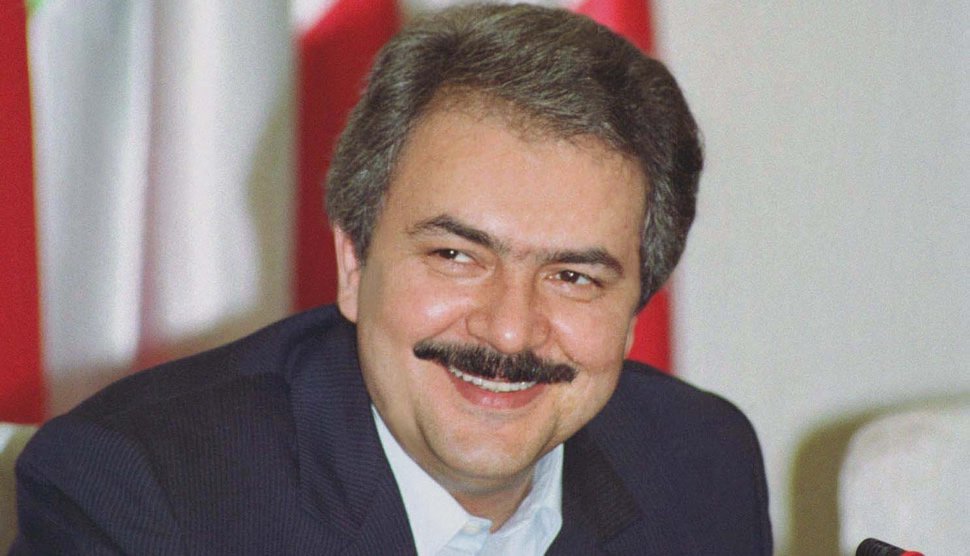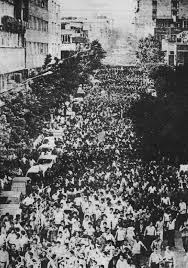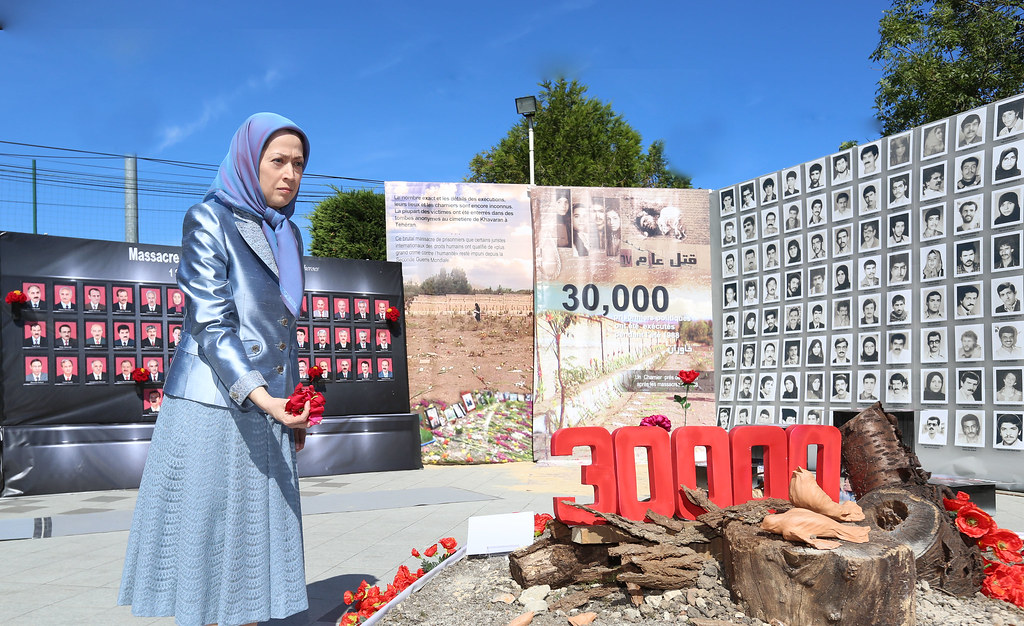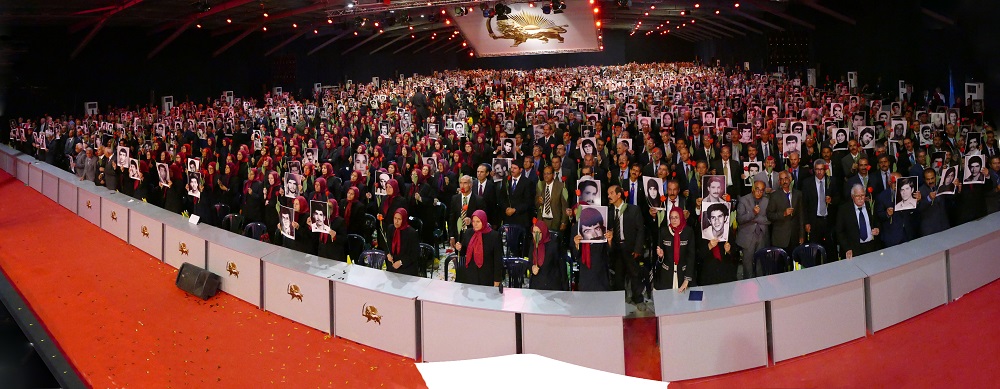1965-1969: The Early Days of the MEK
 During the first few years of the MEK’s existence, its founders focused on laying the groundwork for the movement’s future growth and success. They recruited new members and established leaders within the group to build strong networks of supporters. The MEK’s founders were firmly committed to the idea that the struggle for freedom is a science that requires study to be acquired, so they painstakingly researched all philosophical doctrines that could help them succeed where previous movements had failed. After an exhaustive study, Hanifnejad and his co-founders decided that democratic Islam was the ideology best suited to the aspirations of the Iranian people.
During the first few years of the MEK’s existence, its founders focused on laying the groundwork for the movement’s future growth and success. They recruited new members and established leaders within the group to build strong networks of supporters. The MEK’s founders were firmly committed to the idea that the struggle for freedom is a science that requires study to be acquired, so they painstakingly researched all philosophical doctrines that could help them succeed where previous movements had failed. After an exhaustive study, Hanifnejad and his co-founders decided that democratic Islam was the ideology best suited to the aspirations of the Iranian people.1971: Crackdown and Executions
 Massoud Rajavi was the only surviving leader of the MEK after the Shah’s purge in 1975, thanks to an international campaign to save his life spearheaded by his brother, Kazem Rajavi. Kazem, a respected lawyer and politician in Switzerland, gathered support from several organizations and politicians and convinced them to pressure the Shah to convert Massoud Rajavi’s death sentence to life in prison. One of the politicians involved in the campaign was Francois Mitterrand, the head of the French Socialist Party and future President of France.
Massoud Rajavi was the only surviving leader of the MEK after the Shah’s purge in 1975, thanks to an international campaign to save his life spearheaded by his brother, Kazem Rajavi. Kazem, a respected lawyer and politician in Switzerland, gathered support from several organizations and politicians and convinced them to pressure the Shah to convert Massoud Rajavi’s death sentence to life in prison. One of the politicians involved in the campaign was Francois Mitterrand, the head of the French Socialist Party and future President of France.
1975: A Failed Coup within the MEK
The attempted coup nearly destroyed the MEK, but Massoud Rajavi was able to intercede from his prison cell and restore order to the group. In the fall of 1976, Rajavi issued a 12-point declaration reasserting the MEK’s core ideology and principles. This declaration became the set of guiding principles used by all MEK members in adhering to the organization’s goals.
The 1979 Revolution
1979-1981: Peaceful Protests against the Mullahs’ Theocratic Dictatorship
 The MEK opposed the mullahs’ regime, founded by Ruhollah Khomeini, from the moment it began. The organization warned the Iranian people of the threat posed by the fundamentalist regime, including the repression of women, religious minorities, and opposition groups. The MEK quickly became known as the primary defender of freedom in the country, building a wide base of support among people across Iran. Young people and intellectuals were particularly drawn to the movement, and within two years, the MEK has become the largest political organization in Iran.
The MEK opposed the mullahs’ regime, founded by Ruhollah Khomeini, from the moment it began. The organization warned the Iranian people of the threat posed by the fundamentalist regime, including the repression of women, religious minorities, and opposition groups. The MEK quickly became known as the primary defender of freedom in the country, building a wide base of support among people across Iran. Young people and intellectuals were particularly drawn to the movement, and within two years, the MEK has become the largest political organization in Iran.
Post-1981: Terror at the Hands of Khomeini’s Regime and the Founding of the NCRI
On July 21, 1981, one month after Khomeini began his crackdown, Massoud Rajavi founded the National Council of Resistance of Iran (NCRI), a coalition of Iranian opposition forces dedicated to replacing Khomeini’s religious dictatorship with a democratic, pluralistic, secular state. One week later, on July 29th, the MEK’s leaders fled Iran with the assistance of courageous officers from the Iranian Air Force. Massoud Rajavi sought refuge in France, where he continued the battle for freedom against the Iranian regime.
The MEK and the Iran-Iraq War
1985: The Rise of Women in the MEK
1986: The MEK Relocates to Iraq
Middle East analysts and observers credit the Khomeini’s acceptance of the 1988 ceasefire with Iraq to the NLA’s efforts.
 1988: The Massacre of MEK Members and Supporters
1988: The Massacre of MEK Members and Supporters
Many of those who were executed had already completed their sentences and were awaiting release when they were called before the Death Commissions. Teenagers, pregnant women, and elderly people were among the victims. Bodies were not returned to the families of the victims, and many families never received notification of their loved ones’ fates or whereabouts.
The 1990s and 2000s: The Policy of Appeasement
2016-2018: The MEK’s Relocation to Albania
 In 2016, an international effort led by Mrs. Maryam Rajavi completed the relocation of the MEK members still living in Iraq to a new home in Albania. The relocation came after years of missile attacks by the Iranian regime and its Iraqi proxies. The new location allowed the MEK members to focus all of their efforts on fighting for freedom and democracy in Iran instead of fighting off missile attacks. It was also a major blow for the Iranian regime because the mullahs understand that every step forward for the MEK is a step toward the regime’s destruction.
In 2016, an international effort led by Mrs. Maryam Rajavi completed the relocation of the MEK members still living in Iraq to a new home in Albania. The relocation came after years of missile attacks by the Iranian regime and its Iraqi proxies. The new location allowed the MEK members to focus all of their efforts on fighting for freedom and democracy in Iran instead of fighting off missile attacks. It was also a major blow for the Iranian regime because the mullahs understand that every step forward for the MEK is a step toward the regime’s destruction.Uprising – Continuing Struggle in Iran
The uprising that started in December 2017 in Iran was a powerful sign of unrest that rattled the religious dictatorship and all its factions. The protests started for seemingly economic grievances but rapidly expanded to widespread and continuous calls for the overthrow of the regime in its entirety. Protesters chanted “Death to Khamenei”, “Death to Rouhani”, and “Reformer, Hardliner, the game is now over”, targeting the entirety of the clerical coalition that rules Iran.
The protests continued throughout 2018 and encompassed workers, farmers, rural communities, teachers, defrauded investors, truckers, environmentalists, and women, and students. The protesters denounced the regime’s foreign policy with “Let go of Syria, think about our condition” and “Our enemy is here, but they lie to us that it’s America.”
International human rights organizations such as Amnesty International estimate about 7,000 arrests by the regime during the uprisings and protests, and the regime itself has admitted to at least 4,600 arrests (Hassan Abbasi, Ofogh State TV, June 1, 2019). The Iranian Resistance has reported that as of January 2019, a more accurate figure is around 8,000 according to internal reporting and research. Security forces killed at least 36 persons during the uprisings, 11 of them under brutal torture in regime detention centers.

Resistance Units
The PMOI/MEK’s resistance units have been very active in all cities across Iran, informing and assisting the public on ways to resist the regime. The MEK expanded its “Resistance Units” over the past year. Their activities include torching large billboards of Khamenei and Rouhani in busy districts of Tehran and other cities and destroying regime symbols at Bassij and IRGC centers. They write slogans against the regime, distribute informational leaflets and drape bridges in busy districts of Tehran with huge banners of Mrs. Rajavi. The regime is very alarmed that these activities will encourage the public to further rise against it.
- Mahmoud Alavi, Minister of MOIS, admitted on April 19, 2019, that the regime had arrested 116 Resistance Units of the MEK over the past year. This is a clear acknowledgment of the Resistance Units’ progress and activities.
- A report by the MOIS in East Azerbaijan province on April 22, 2019, stated, that MEK activities in the province increased from March 2018 to March 2019. The report said, “The MEK exploited economic and social problems to expand its activities last year. Some 60 persons associated with the group were arrested and more than 50 others were identified and warned.”
- Fars News Agency, affiliated with IRGC reported on August 5, 2018: “In the turmoil of January 2018, the PMOI identified opportunities and capacities inside the country and formally ordered operations to be launched through Resistance Units. These units consisted of 2 to 5 MEK members.”
- State-run Baharestaneh website – August 28, 2018: “Today, the PMOI has infiltrated in all social sectors and are directing them, including truck drivers, bazaar merchants, teachers, and workers.”
- State-run Baharestaneh website – August 28, 2018: “The PMOI have formed groups called ‘Resistance Units’ that have the power of replication, and the potential and ability to replace their leaders in the field.”
- Eje’I, the spokesperson for the regime’s Judiciary: “Nowadays some people chant slogans against the Judiciary and the authorities. Be careful, God forbid, a PMOI member might come in the people’s midst and people will follow him. We must be careful not to be abused by the PMOI.”
- Ghasemi, an IRGC commander – August 7, 2018: “We have a problem, namely the PMOI. We must be careful not to neglect this. They have infiltrated some organizations and IRGC ranks.”
Popular Councils
The PMOI/MEK has also organized “popular councils” which have been very active in all cities across Iran, informing and assisting the public on ways to resist the regime. While members of Resistance Units are from the younger generation, members of popular councils are people from all ages and sectors of the population who take part in certain social activities.
These councils have provided advice and opportunities to organize independently for cooperative assistance to stricken compatriots ignored by the corrupt clerical regime. One exemplary campaign was during the disastrous floods that overtook Iran in April, May, and June. PMOI/MEK popular councils gathered material assistance donated in various neighborhoods and trucked and distributed them to stricken areas. People bitterly complaining that the government had done nothing to assist them met the council members with a warm welcome.

Regime’s Quandary
The regime faces a dilemma by pretending that the PMOI/MEK has no popular support in Iran, and yet increasingly needing to point out the active presence of PMOI/MEK resistance units and councils to dissuade the public from joining them. This trend has led to increasing news of resistance activities in regime news media in recent months.
Public news of sentences of PMOI/MEK activists has been frequently surfacing in the news media. On May 20, a so-called revolutionary court in Tehran sentenced a 34-year-old PMOI/MEK activist and member of a resistance unit to death and three others to five years in prison for engaging in non-violent dissemination of anti-regime literature.
The PMOI/MEK has announced that the actual figures for arrests and sentences have been much higher. Due to various security concerns and the need for secrecy to protect sources and methods, the PMOI/MEK published a limited list of names recently of 28 detainees in over 13 cities, appealing to international human rights organizations to take urgent action for their release.
In the past 12 months up to June 2019, popular uprisings and protests have swept through 556 cities and towns and industrial centers in Iran, consisting of 1354 workers’ actions in 146 cities.
A brief tally of organized protests and strikes is:
- Four rounds of widespread national strikes by truckers in 323 cities
- Three rounds of national strikes by teachers in 104 cities from 348 academic institutions
- Widespread bazaar (business) strikes in 12 provinces
- A 38-day strike and protest marches by the Ahwaz steelworkers union
- A 28-day strike and protest marches by the Haft-Tapeh sugar cane workers in Shush
- Railroad workers strike in 35 cities protesting unpaid salaries
- Municipal workers strike in 60 cities protesting unpaid salaries
PMOI/MEK resistance units and councils with thousands of dedicated members in over 150 cities and towns continue to organize and campaign for regime change in Iran leading to daily protest actions in various cities.
ASHRAF III, RISING From the ASHES: Iranian Opposition Terrifies Tehran Rulers; A European Delegation Report Paperback – February 2019

Introducing a new book by Struan Stevenson
This European delegation report recalls the suffering of several thousand men and women members of the Iranian democratic opposition, People’s Mojahedin Organization of Iran (PMOI or MEK). They were living in exile in Camp Ashraf and later Camp Liberty in Iraq. After the withdrawal of the US military, they were left at the mercy of the vicious Iraqi Prime Minister Nouri al-Maliki and his masters in Tehran. Finally, the tiny country of Albania agreed to provide them with a safe haven in Tirana.
Now the “Ashrafis” have a home and have made friends with the local Albanians. Their fortitude and stamina have acted as a beacon of hope for the 80 million beleaguered citizens of Iran who hope and pray for freedom from oppression and now look to the MEK as the harbingers of the future of democracy, justice, and peace.
The author visited the Iranian opposition center, Ashraf III, with 2 senior Members of the European Parliament, Tunne Kelam & Jaromir Stetina, and spoke with the residents to hear their stories as well as observing the progress they have made in setting up their new home.
The report goes into some detail of the chaos that has engulfed Iran, leading to the first anniversary of the nationwide uprising. It shows how the clerical regime has reacted with brutal force, killing, imprisoning, and intimidating the Iranian population, rather than seeking to resolve the crisis. The report shows how the mullahs have reacted to the threats to their regime by ramping up their sponsorship of international terror and cyberwarfare, as well as a demonization campaign against their main organized opposition.
The report is highly critical of the EU’s High Representative for Foreign Affairs – Federica Mogherini – for her continued attempts to ignore the blatant abuse of human rights that take place in Iran on a daily basis.
To buy the book, order on Amazon:
https://www.amazon.com/dp/1527236935/ref=sr_1_1?ie=UTF8&qid=1549416893&sr=8-1&keywords=9781527236936
Virtual Tour of Memorable Exhibition in Ashraf 3

Museum 120 years of struggle for freedom in Iran- Ashraf-3 Albania home to members of the MEK
Written by Staff Writer on 20 January 2020.
120 YEARS OF STRUGGLE FOR FREEDOM
Explore the Iranian Resistance’s historical exhibition entitled, “120 Years of Struggle for Freedom,” that encapsulates the glorious struggle of Iranians for freedom.
A struggle to break free of the bondage of feudal Shahs and reactionary clerics to enter the modern era of democratic-republican governance. A struggle that has faced innumerable challenges through the past century and even today.
Explore many of the spaces and displays in this museum and learn about the rich history of a heroic effort by Iranians to achieve freedom and progressive society, and the high price that they have paid for it in the tens of thousands of lives laid down for this noble goal.
Virtual Tour of Memorable Exhibition in Ashraf 3
Launch Tour – Explore Exhibition
Nationwide Protests, November 2019 and January 2020
Iran witnessed a series of protests in November 2019 and January 2020 that were unprecedented in the past four decades.
Shaking the regime in its entirety, the uprising in November quickly erupted in at least 191 cities. Assessments indicate that it was the most important challenge the Iranian regime has ever faced.
The protests were sparked by a gas price hike, however, due to the explosive situation of the society, they dramatically expanded all over the country in just 24 hours. Demanding regime change, Iranian people chanted against the Supreme Leader and the regime in its entirety.
The high volume of the protests forced the regime to dispatch all its suppressive forces, in particular the Islamic Revolutionary Guards Corps (IRGC), onto the streets, killing people in cold blood.
The Chairman of the Parliament’s National Security Committee Mojtaba Zolnour admitted that there had been harsh clashes between angry protesters and security forces in 800 locations across the country, including 147 points just in the capital Tehran.
Senior commanders of the IRGC who had been dispatched to the scenes, later compared the conflicts with the harshest scenes of the Iran-Iraq war saying: “God saved the regime.“
Confronting the bloody suppression, the protesters, mainly from the low sectors of the society, defended themselves, setting fire to some 900 gas-stations, 1000 governmental banks, many governorate buildings, and state seminaries.
One day after the beginning of protests, the top officials of the regime, including the Supreme Leader, stressed on the role of the People’s Mojahedin, or Mujahedin-e Khalq (PMOI/MEK), and its Resistance Units in organizing and leading the protests.
In order to cover the dimension of suppression and prevent the expansion of the protests throughout the country, in an unprecedented measure, the Iranian regime shut down the Internet for more than a week.
Relying on its vast social network, the MEK announced the death toll on a daily basis. Based on the MEK’s information, some 1500 protesters were killed, 4000 were injured, and another 12000 were arrested. This death toll was later confirmed by the top officials of the US and Reuters. Reuters referred to three sources in the regime’s Interior Ministry. Iran’s regime not only has not provided any information about the victims of the Iran protests but has prevented the issue from being raised in public; however, so far the MEK has revealed the names of more than 750 martyrs.
In fear of a new bout of protests and eruption of the society, the regime prevented the families to hold mourning ceremonies for the victims.
The November 2019 uprising happened less than two years after the nationwide uprising in January 2018 that erupted in 140 cities across the country. This indicates the deteriorating situation in Iranian society that will result in an end to the mullahs’ rule, the inefficiency of suppression as it was before, and uncontrollable situation for the regime.
Protesting against the downing of a Ukrainian airliner by the IRGC, which left 176 people dead in January 2020, once again Iranian people flooded the streets in Tehran and cities of ninety provinces in Iran. This time, college students representing the middle class in Iran were in the front line. The slogans were focused on the Supreme Leader Ali Khamenei and the IRGC that represent the regime in its entirety.
Chanting “down with the tyrants, be it the Shah or the Leader (referring to the Supreme Leader)” and “Neither the crown nor the turban. The mullahs are goners,” protesters showed that the Iranian people see the future in denying the dictatorship in any form and demanding democracy.
Demanding regime change in Iran is the common point of the protests in Iran.
By chanting “Reformists! Hardliners! The GAME IS OVER!” in January 2018 protests, Iranian people disavowed the regime in its entirety. In August 2018, a prominent theoretician of the Iran regime, Saied Hajjarian, said: “If there will be a situation like other democratic countries in Iran, holding transparent elections without interference by the government and taking off the cover of greenery, there would be none of us, neither you nor me, there will be neither hardliners nor reformist.”
Rejecting both the past (monarchy) — and the present (theocracy), Iranian people called for a better and different future in the January 2020 uprising.








